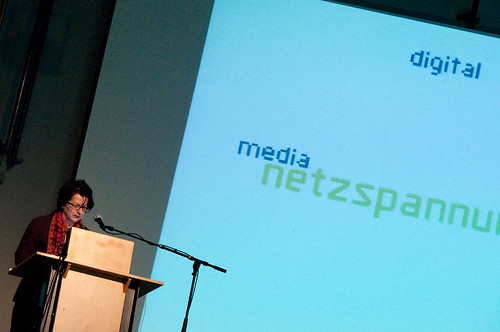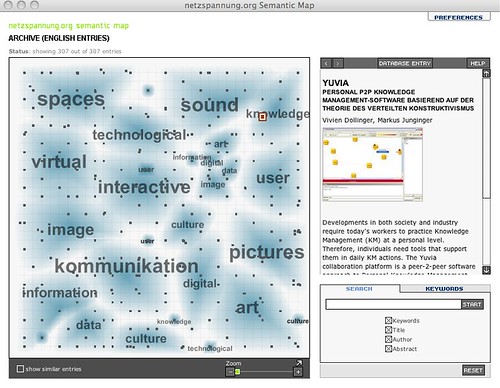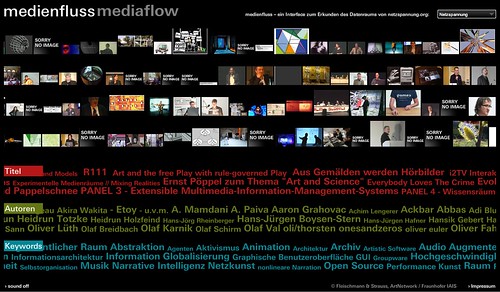
What is going on in Media art? We wanted to build a picture of the current development. When we started there was nothing, we had no content. How do we build an archive when nothing is there? We thought about what partners would be important? We started with an e-mail poll in 1997/1998 and asked our international media art community: what would be important when we build such a platform?
Since 1998 Netzspannung.org was conceptually prepared and in 2001 it was first launched. In this time we had the issue of selection because we wanted it to be a selective process of more than only the editorial board. We were thinking about programs where more people could be involved and we have created open areas in Netzspannung. It is used as a pool or resource of information. The data is structured as a usual archive around the author and the work and all is brought into the context. To get a better overview of what is in the archive we developed different interfaces for the archives.
One of the interfaces developed is the Semantic Map. There is editorial content and content from people “outside” who use the Net Collector. The semantic map is organizing the content in a new way so the archive is constantly living and growing. The archive will always look different, it shows relations and connections to other works. It is a semi-automatic self organizing semantic map. It combines semantic and dynamic zooming. The semantic map has no center, it changes depending on the subject.

Semantic structuring & visualization
1 Machine based text analysis
2 Kohonen Neural Network
3 Semi-automatic keywording and clustering of the database
4 Discover new and hidden relations
The interface Medienfluss (2007) is a flow of images and text in the Netzspannung database. It an explorative interface based on the premise, don’t search but find. It is a time based narration of the archive allowing for re-reading of the archive.

Q&A
During the Q&A there is a critique on the semantic map with its ever changing interface. It is stated that we need a reference point for information and that semantic maps are interesting for specific researchers but as a public interface they are useless.
“….. but as a public interface they are useless.”
What a misleading statement!
The Semantic Map gives an immediate overview of the archives content such as “spaces”, “sound”, “virtual”, “user”, “image”, “interactive” … The Semantic Map structures the texts, works, lecturers content into clusters and shows the most prominent topics. So you see st first view what the archive is about. Simultanously you see the detailed description of a respective database entry. The Semantic Map was awarded as one of the most important products of the future.
http://www.ullsteinbuchverlage.de/econ/buch.php?id=11788&page=buchaz
The statement “….. but as a public interface they are useless†was from the critical audience member during the Q&A.
Thanks for for your explanation why the Semantic Map can also serve as a very useful interface.